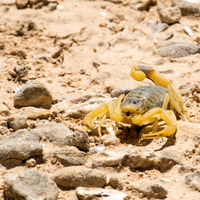Login
Subscribevenom

Bull Ant Venom Evolved to Make Bites More Painful to Mammals
Dan Robitzski | Jul 5, 2022 | 2 min read
A peptide found in bull ant venom closely resembles a hormone of its primary predator, triggering hypersensitivity and making subsequent bites even more painful than the ones that came before.

Study Questions Sterility of Snake and Spider Venoms
Christie Wilcox, PhD | Jan 31, 2022 | 8 min read
In work that has not yet been peer-reviewed, researchers present evidence that microbes can and do live inside the venom glands of several dangerous species. It remains unclear whether they’re to blame for infections linked to bites.

Book Club Discussion of Venomous by Christie Wilcox
The Scientist Social Club | Dec 10, 2021 | 1 min read
The Scientist Social Club sat down with the author.

Sea Snake “Attacks” Are Cases of Mistaken Identity: Study
Christie Wilcox, PhD | Aug 19, 2021 | 6 min read
The Scientist spoke to marine biologist Tim Lynch, who dusted off 25-year-old data from his PhD to figure out why olive sea snakes approach divers so often. He says the animals, especially the males, likely confuse people for potential mates.

How a Centipede Survives its Own Species’ Venom
Shawna Williams | Nov 1, 2020 | 2 min read
The same toxin targets different receptors in prey and conspecifics to deliver either a lethal or non-lethal blow.

CAR T Cell Adds Scorpion Venom to Tackle Tumor Heterogeneity
Amy Schleunes | Mar 24, 2020 | 5 min read
A newly engineered CAR T cell that incorporates a peptide isolated from the venom of the deathstalker scorpion has broad brain tumor–binding capabilities that will be investigated in an upcoming clinical trial.

Image of the Day: Scorpion Venom for Arthritis
Amy Schleunes | Mar 17, 2020 | 1 min read
A mouse model of rheumatoid arthritis reveals that a tiny protein in scorpion venom can deliver steroids to affected joints.

Caught on Camera
The Scientist Staff | Jan 1, 2018 | 1 min read
Selected Images of the Day from the-scientist.com

Frog Skin Yields Potent Painkillers, but None Clinic Ready
Shawna Williams | Jan 1, 2018 | 2 min read
Decades after their discovery by bioprospectors, amphibian-derived analgesics continue to attract scientific attention.

Sea Anemone Toxin Could Treat Autoimmunity
Jef Akst | Jan 1, 2018 | 2 min read
If successful, the treatments could alleviate patients’ pain by reducing inflammation.

Sourcing Painkillers from Scorpions’ Stings
Abby Olena, PhD | Jan 1, 2018 | 2 min read
Compounds in the arachnids’ venom interact with ion channels to both cause and block pain.

Mining Spider Toxins for Analgesic Clues
Catherine Offord | Jan 1, 2018 | 2 min read
Arachnids harbor a plentiful array of molecules that target mammalian pain receptors.

Researchers Mine Centipede Toxins for Analgesics
Catherine Offord | Jan 1, 2018 | 1 min read
Venomous centipedes may harbor a clue to the creation of a successful pain-killing compound for humans.

Novel Analgesics at a Snail’s Pace
Bob Grant | Jan 1, 2018 | 3 min read
Studying cone snail venom has yielded novel pain pathways, but the peptides that function as toxins are difficult to translate into drugs.

Animal Analgesics
The Scientist Staff | Jan 1, 2018 | 3 min read
A cornucopia of toxins in the animal kingdom could provide inspiration for novel painkillers, but so far, effective drugs have proven elusive.

Snake Venoms Cause and Block Pain
Kerry Grens | Jan 1, 2018 | 2 min read
Painful snake bites may hold clues to developing analgesic drugs.

Prospecting for Painkillers
The Scientist Staff | Dec 31, 2017 | 1 min read
Cone snail venom researcher Mandë Holford discusses the therapeutic potential of toxins found in animals.

Image of the Day: Overkill
The Scientist Staff and The Scientist Staff | Oct 6, 2017 | 1 min read
The Sakishima habu (pitviper; Protobothrops elegans) can compensate for inept traits in the chemical composition of its venom by overdosing its prey.

Image of the Day: Fanged Fish
The Scientist Staff | Apr 13, 2017 | 1 min read
Poisonous fang blennies (Meiacanthus) are only around 2 inches long but, with their tiny fangs, they can inject predators with a venom that has potent hypotensive effects.
